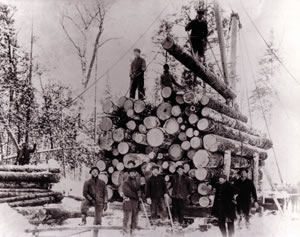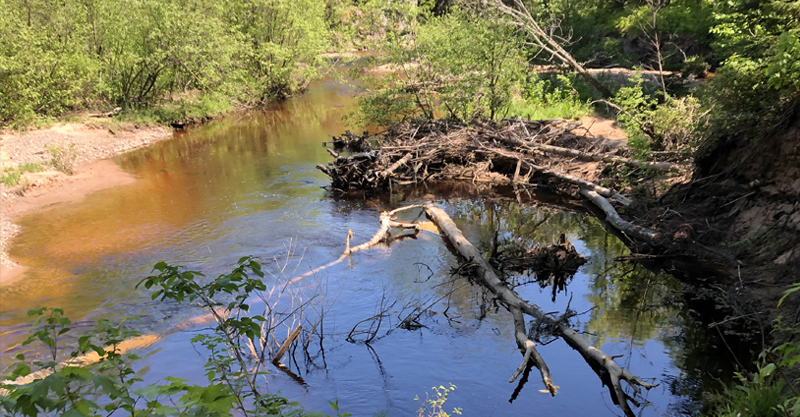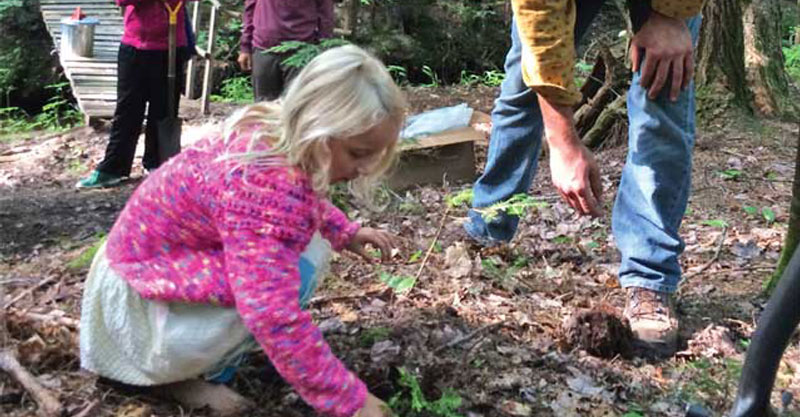from Marquette Monthly December, 2012
By Jon Magnuson
As remote Northern Michigan cabins are boarded up for the winter, local stores open doors with discount Christmas sales and holiday lights are strung across neighborhood porches. Deep in forests across the Upper Peninsula, 10,000 small Northern white cedar seedlings cling tenuously to life, buried under a first snowfall. Six months ago, human hands first gently placed them into dark soil on edges of forgotten burned-over meadows, under wooded canopies of remote riverbanks, and along trails bordering rugged Lake Superior shorelines.

Blessed, prayed for, and sung into life by groups of youth volunteers, gardeners, Buddhist priests, Jewish cantors, Christian pastors and American Indian spiritual leaders during a twenty-one day initiative involving 300 volunteers, these seedlings remain for some of us as signs of hope for a threatened environment. They are also a testament to the healing power of the human spirit––a story worth telling.
The origins of this quiet drama find their beginnings in the deep stirrings of the human heart. Mircea Eliade, the late religious historian of the University of Chicago, frequently highlighted a particular theme common in the teachings of the world’s oldest religions. He called it “eternal return.” Roman Catholic priest and environmentalist Thomas Berry identified it for our own times as “The Great Turning.”
Both Eliade and Berry were referring to a secret hidden in the turning of seasons, the dormancy of winter and the far-off promise of spring: the ever present human hunger to bow before a great mystery, some source of life and promise larger than ourselves.
The symbol of the tree lies at the heart of such an understanding for many of the world’s great spiritual traditions and plays a central role in both Jewish and Christian images of creation and redemption. It’s also said the Buddha first gained enlightenment while sitting under a tree.
Here in Northern Michigan’s Upper Peninsula, the cedar tree (Gisheek in the Anishnaabe languages) continues to hold a special sacred place in the teachings and legends of Ojibwe, Odawa and Potowatomi peoples. Traditional Native American practices in our regions of the Great Lakes regularly use cedar boughs and needles in ceremonies, during prayers, and for offerings of thanksgiving. Among the Peoples of the Three Fires Gisheek is respected and honored as one of four sacred medicines.
Unsettling and unfortunate as it may be, over the last fifty years Northern white cedar has silently––and shamefully without protest or public notice––come under threat of survival in the Upper Great Lakes Basin.

This was news for most of us. In tree planting preparations during the spring of 2012, we were dismayed to discover no commercial nursery in the Upper Peninsula grows Northern white cedar for public distribution. Because of extremely slow growth patterns, it has not been replanted after logging operations by the timber industry. Ecologists and many foresters now recognize that post-harvest practices of planting single replacement species (or monocultures) like red pine, a popular, fast-growing conifer expedient for commercial timber, actually has reduced forest vitality and curtailed biodiversity. A retired staff member for the Michigan Department of Natural Resources reminded us this summer that by DNR estimates, thirty percent of cedar has been lost from the landscape of the Upper Peninsula over the last fifty years.
This news confirmed our decision to organize a collaborative effort to coordinate a restoration project. We chose a core team of youth volunteers, as with past summer projects. The challenges proved formidable. Our project leader, with his nine-year-old son Willie, drove 600 miles to pick up the 10,000 four-year-old cedar seedlings from a tree nursery near Grand Rapids. Because of sensitivity in the transplanting process, the seedlings needed to be handled carefully. Two of our local Marquette grocery stores (Super One and Jack’s IGA) kindly offered refrigerated storage space to keep seedlings over the critical transition time until we were able to distribute them for planting.

One of our team’s intentions was to help spread the news of how Gisheek (cedar) plays a role in sustaining the integrity of our Upper Peninsula ecosystem. We knew cedar provides essential nutrients for white-tailed deer, but most of us were unaware of its effectiveness in catching insects in its fine, short needles. We learned that net-like webs among close-growing cedar branches catch tiny midges and provide food for birds. We discovered that stands of cedar actually provide a peculiar kind of GPS food map, a navigation system for migrations of some of Michigan’s most cherished songbird populations.
Equally surprising for many of us was that the small, twisted cedars growing along the edges of Lake Superior, though modest in appearance and size, carry another secret. Growing no more than twenty to thirty feet, many of these cedar trees were documented in 1994 by Canadian researchers to be part of a magnificent unacknowledged old-growth forest that actually dates back 400 to 800 years. No one had a clue.
June 17
Today is the first of our distribution events. We’re in the parking lot of Marquette’s MooseWood Nature Center. The center’s director, Andrew Bek, and his son Ian are helping us set up tents where our band will play, led by local musician Obadiah Metivier. His percussionist wears a long cotton dress and has placed a cedar wreath in her hair. Sounds of a wind flute, chimes and drums soon fill the air. One of five youth volunteers from Marquette County’s Juvenile Court sits near a card table with cookies and fruit punch, standing when visitors approach, extending a hand and introducing herself. Two thousand seedlings are bundled in clumps of twine and burlap and are piled on the flatbed of a Ford pickup truck. We’re awaiting the first of what we expect to be a hundred or more volunteers and other individuals who will be arriving to make a modest donation and depart with trees for themselves and various faith communities and organizations.
An hour later, following prayers and hymns from four religious traditions, Ojibwe, Jewish, Buddhist and Christian, Peter Holodnick, reforestation technician with the Hiawatha National Forest, talks about his years of experience planting trees in Alaska, California and Wyoming. He stands in the middle of our circle of forty to fifty volunteers, diverse in age and background, and speaks to us about the planting process.

“Above all, keep the seedlings’ roots loosely bound in burlap or a paper bag; make sure they are moist and cool. Store them in shaded, cool areas. Don’t wrap them in plastic. They’re living, growing things and need to breathe. Don’t handle seedlings more than necessary. And don’t expose the roots to open air or sunlight until the moment you’re ready to plant.”
“Remember, there are no perfect planting sites. Cedar can do well in regenerating burned-over sites, but they can also flourish in the shade of a mature forest and lots of environments in between.”
Later in the morning, I watch a thirteen-year-old unwrap and separate a group of twenty-five seedlings, each eighteen to twenty-four inches high, for distribution. I watch one of our youth volunteers, remembering him only days ago, initially hesitant, distracted, rebellious. He works intentionally now, separating the seedlings carefully, his hands moving gently, gracefully, unfolding the tangled roots like undoing fine threads of a delicate tapestry.
June 27
Stepping off the sixteen-foot aluminum Forest Service boat at Williams Landing for the first time, there’s a sense of expectation. We’ve arrived at Grand Island, a recreational area a half-mile off the shore from Munising, part of the Hiawatha National Forest. We’re carrying four oversized burlap bags with 400 Northern white cedar seedlings, ready to join two Forest Service interns and Forest Service botanist Deb LeBlanc who’ll be leading us to a meadow three miles inland where we’ll be assisting in transplanting wild Canadian rye and helping restore a portion of this remote meadow with the planting of Gisheek.
Mid-morning, we take a break and the energetic, experienced, rosy-cheeked Forest Service botanist and I muse about the meadow. “Look over there on the edge of the meadow––notice the monarch butterflies. We first planted milkweed only a few years ago. We noticed the next summer migrating butterflies found us. These small creatures have a sixth sense and can seek out milkweed, the only plant they will eat, for miles. Now, during summer season, they land here, hundreds, sometimes thousands, to feed on milkweed and pollinate our native plants. This meadow has becoming a resting place, a stop for renewal, rest and rejuvenation.”
It’s a hot afternoon. One of our project leaders, Ray Hasenauer, a retired social worker and family therapist with a bandana wrapped around his forehead, gathers our youth volunteers, collecting tools, sharing cups of water from a cooler. Turning to leave for the walk to the boat ramp, I remember that the long-time survival of seedlings depends on many variables, but cedar, I’ve learned, is extremely resilient, in part because it grows slowly. Even so, survival of cedar is successful if only sixty to seventy percent survive after transplanting. This is nature’s hard way.
I take a last glance at the meadow. A hundred years from now, as flocks of fragile monarchs pass through on their annual 2,000-mile flight from Canada to the forest sanctuaries of Mexico’s Piedra Herrada, odds are good that some will land here for rest. On the edge of this meadow filled with milkweed, a few (or more) of these cedars––planted here by a group of youth struggling to make sense out of memories, like many of us, of abuse, addiction and fractured homes––will stand, tall and elegant, to welcome them.
July 6
Not far from the rumbling sounds of trucks traveling back and forth during construction for Rio Tinto’s Kennecott Eagle mine off the Triple A road, a group of fifteen of us arrives in a pickup truck, a van and two sedans, parking along a shaded gravel road on the banks of the Yellow Dog River. We have 300 seedlings to plant today.
Among our group are volunteers from the Big Bay Girl Scout Troop. After instructions are given, we begin to spread out in teams among the sprouting ferns and tangled aspen. Emily Whittaker, director for the nonprofit Yellow Dog Watershed Preserve, is present. I ask her whether these ten- and eleven-year-old girls need help with the shovels, turning over what we’re discovering is some resistant, rocky root-bound soil. She replies, “We often like to joke with each other that we should be wearing T-shirts saying “Big Bay Girls.” Moving down the riverbank with a ten-year-old, she turns, smiling, and says, “Watch us.”
Following lunch, we move swiftly to plant the remaining few seedlings. Off to my left, I notice one of our volunteers, whose father, a retired mining engineer, has been an outspoken critic of the nearby sulfide (nonferrous) mine. Her father is convinced that permits were slipped through the state’s approval process and insufficient safeguards are in place to prevent toxins from entering the watershed.
She kneels alone on the forest floor, placing the seedling gently, vertically, into the ground, avoiding any upturn of its dangling root base that eventually could kill the tree in coming years (a mistake professional planters call “J-planting.”)
I carry a bucket of a dozen tree seedlings to a planting site, then turn to watch, for a brief moment, the engineer’s daughter who has paused after packing the earth down around the newly planted tree. Both hands are cupped around the seedling. Her head is bowed.
Lon Emerick, former speech pathologist and university professor, known in a second career as one of our region’s most respected naturalists and writers, once remarked to me as we walked along a trail near Marquette County’s picturesque Little Presque Isle, “Tourists who visit the Upper Peninsula and many folks who live here see the natural environment around us as a beautiful postcard, a kind of background for weekend recreational activities. It’s important we help people understand it’s more than that. It’s a living, breathing, fragile ecosystem needing attention and care.”
If he’s right, there’s trouble ahead. In a flurry of unprecedented activity, international mining companies, biomass energy salesmen, and representatives of the emerging lucrative water extraction industry are drilling test wells and purchasing new leases across the Upper Great Lakes Basin’s watersheds and forests.
Most of the public is unaware that careless development projects over the last fifty years around Lake Superior have left us with what the EPA and Environmental Canada have designated as eight AOCs (Areas of Concern.) These are sites to which the government has committed hundreds of millions of dollars to clean up toxic wastes (tailings and contaminated sludge) left by industries ended decades ago.
This time around, the threat is greater. Mining and lumbering companies are no longer nationally or regionally based. They exist in competitive global stock markets. Their business is to lock in short-term profits. Battle lines are being drawn in our local communities around what this means for competing definitions of wise stewardship, healthy economics and polluted landscapes.
Despite the decisions that will be made and the consequences that will follow, it’s worth remembering the volunteers, especially the young, who, kneeling on river banks, under canopied forests, and high along ridges, placed seedlings in the ground with good energy, humor and joy. They were all part of the Great Turning, the promise of an eternal return.
History teaches us that even the smallest of such gentle, life-giving efforts always have stood, from the beginning of human time, in bold defiance of powers of defilement and exploitation.
During our first planting in June, Jeff Noble, our project’s technical director, distributed written instructions to volunteers. Suggestions were made about handling seedlings and the least intrusive use of shovels and spades. He closed with these words:
“Let us perform this task mindfully and with deliberation, to the best of our ability. Keep us completely in this moment. Let us plant each tree with an attitude of respect toward all others who share this work with us. With love and care for the trees we are trying to nurture and with great reverence for the blessing of working with our hands, led by our hearts.”
At 5:00 p.m., July 11, framed by songs, prayers and eighty-five supporters and friends, the ten-thousandth Northern white cedar tree was planted next to Presque Isle Park Pavilion in Marquette.
Editor’s Note: Additional partners involved with the Cedar Tree Institute’s 2012 Manitou Project included the Upper Peninsula Children’s Museum, Voices for Youth, Teaching Family Homes, Cold Stream Farms, and the Lac Vieux Desert Band of Lake Superior Chippewa Indians.
Ninety-three individuals made personal financial donations to support the cost of the project. Mari Feld and Mike Shelafoe served as team leaders.
Tree distribution sites during the twenty-one days of the project were provided by the MooseWood Nature Center, Fortune Lake Lutheran Camp near Crystal Falls and Redeemer Lutheran Church in Newberry.
Archival giclee colored prints of the art commissioned for this project, “Gisheek: Spirit of the Cedar” are available for a donation here.



